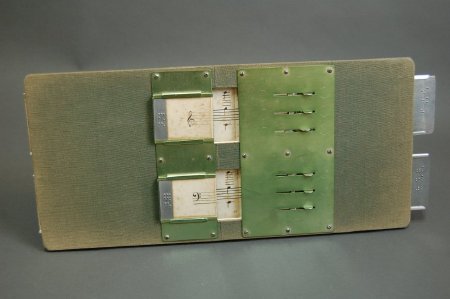Object ID:
2018.18
Title:
Thiberge Auto Teaching Machine
Creator:
Thiberge, Raymond
Description:
Rectangular wooden board, covered with green linen, a stand is hinged to the back, braced with green linen tape; two (2) green tinted rectangular aluminum plates are screwed to the front, on either side of a stacked pair of windows; the left plate has brackets to hold two removable aluminum and paper cards, protected by a square of clear plastic, the upper card has a treble clef, the lower card has a base clef; the right plate holds a stack of six slots, each with a protruding aluminum tab, by sliding the tabs to the left an aluminum plate covers the contents of the central window; there are two horizontal tracks, stacked one on top of the other, in the main board; these tracks hold a sliding bright aluminum tray with a curled edge on top and bottom; the left side of each tray holds a paper card with eleven (11) series of three (3) musical quarter notes located at different places on a musical staff; the right hand side of each tray holds an aluminum card with the braille equivalent; as the tray is pushed to the left, a series of notes is revealed in the central window, and the corresponding braille symbol emerges on the right hand side; the notes in the central window can be revealed or obscrured by means of the tabs on the right hand plate on the front.
Dimensions:
H-7.5 W-16.75 D-0.75 inches
Date:
1946-1955
Made by:
American Foundation for Overseas Blind
Place of Origin:
Paris, France
Provenance:
Raymond Thiberge (1880-1968) lost his vision as a boy of nine, and attended the Institution des Jeunes Avelgles in Paris, France, where he excelled on the piano. In 1903 he became the organist and choirmaster at the Châtillon sur Seine. In 1921 he joined the staff of the Ecole Normale de Musique. In 1929, he founded his own Institute of Musical Pedogogy. By 1912, Thiberge had already invented this teaching machine, which allowed him to teach sighted students, and by 1933 had introduced a commercial version in partnership with the American Braille Press. This version dates between 1946, when the Press was renamed the American Foundation for Overseas Blind, and 1955, when an AFOB catalog did not include it. See notes for details on how the machine was used.
Credit Line:
Gift of Mireille Duhen, 2018.18.
